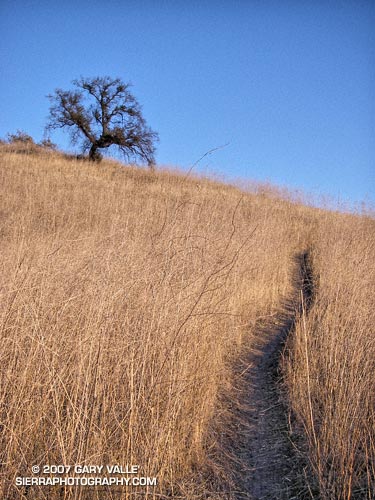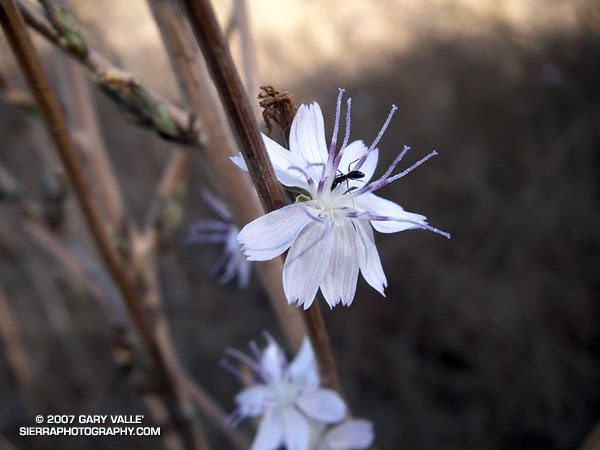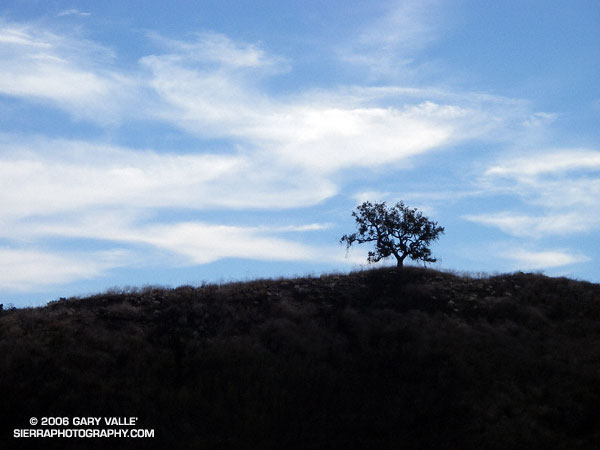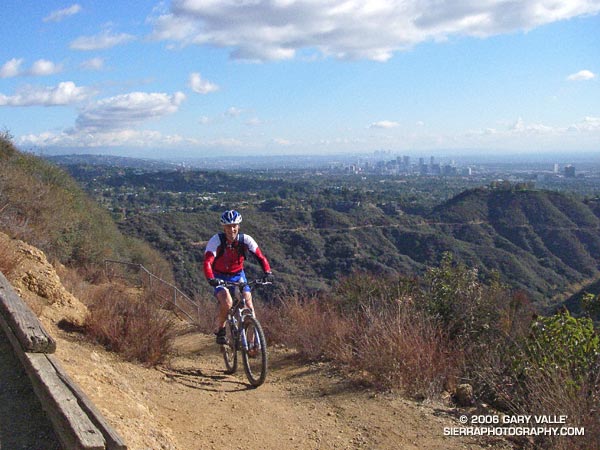
Hillside oak and trail near Laskey Mesa. From a run in Upper Las Virgenes Canyon Open Space Preserve (formerly Ahmanson Ranch).

Hillside oak and trail near Laskey Mesa. From a run in Upper Las Virgenes Canyon Open Space Preserve (formerly Ahmanson Ranch).

An ant forages among the florets of a wreath plant.
I’ve run past wreath plants thousands of times in the chaparral of local open space areas. At a glance, the nondescript wiry brown plant isn’t very appealing. But it’s one of a few plants you’ll see blooming in the chaparral in the Fall, so on a run this last November I took a closer look. This revealed a lavender-tinged composite flower that is anything but mundane. And, as I was to discover, a case of probable mistaken identity, and an example of one of the ways new species occur.
Three field guides in my library identify the plant pictured above as Twiggy Wreath Plant (Stephanomeria virgata). But, as discussed by Tom Chester, there is some confusion regarding it’s characteristics and identity. It could be the case that many Southern California plants previously identified as S. virgata may actually be San Diego Wreath Plant (S. diegensis), including those in the Santa Monica Mountains.
The plants are very similar, but according to the identification key for the genus Stephanomeria in the Jepson Manual can be distinguished by a groove along the length of a seed (achene). This isn’t something easily done in the field. The achenes are so tiny that they are best seen in a strong loupe or a low power microscope. Wayne’s World Volume 9 (Number 3) Fall 2000 has some photographs of the achenes and groove.
So why are S. virgata and S. diegensis so similar? The genetic relationship of various members of the genus Stephanomeria has been researched and it appears likely that S. diegensis is a relatively recent species that resulted from a natural cross of S. exigua and S. virgata.
The photograph of the foraging ant was taken on a run at Sage Ranch on November 5, 2006. Based on examination of some achenes from wreath plants in the area, the plant is probably Stephanomeria diegensis.
Technical papers:
Genetic Evidence for the Hybrid Origin of the Diploid Plant Stephanomeria diegensis
G. P. Gallez, L. D. Gottlieb
Evolution, Vol. 36, No. 6 (Nov., 1982), pp. 1158-1167
Phylogeny of Stephanomeria and related genera (compositae–lactuceae) based on analysis of 18S–26S nuclear rDNA ITS and ETS sequences
Joongku Lee, Bruce G. Baldwin and L. D. Gottlieb
American Journal of Botany. 2002;89:160-168

The open space areas in which I run would normally be lush and green by this time of year, particularly when there is an El Niño. But in the past 231 days (including today) the official weather station for Los Angeles has recorded only 1.31 inches of rain, and the hills remain a dank sun bleached gray-brown.
As mentioned in my post The Color of Rain, usually when there’s an El Niño, wet Winter weather can be expected to occur in Southern California. This year’s El Nino was late to develop, became stronger than expected, and may have already peaked.
Warm water in the tropical western Pacific contributes to the development of an El Niño, and studies show this pool of warm water has been increasing in temperature, perhaps increasing the strength and frequency of El Nino’s. The quirkiness of this year’s El Niño may be related to these changes.
Is any relief to our drought in sight? Not in the short term. A system forecast to affect the Los Angeles area Thursday and Friday will likely result in cooler temperatures and more wind, but little – if any – rain*.
In his blog Atmospheric Insights, NWS scientist Ed Berry discusses the possibility of a high impact precipitation event developing in California later this January*. A flow pattern with a strong lower latitude jet stream is typically associated with El Niño induced precipitation events in California.
California weather this rain season will be closely monitored by scientists participating in NOAA’s Hydrometeorological Testbed (HMT) Program. This program is “aimed at accelerating the infusion of new technologies, models, and scientific results from the research community into daily forecasting operations of the National Weather Service (NWS) and its River Forecast Centers (RFCs).”
The photograph of the dry grasslands in the Simi Hills west of Rocketdyne was taken on a run to the northern boundary of the Upper Las Virgenes Open Space Preserve on December 24, 2006. The photograph of the green hills in the Ahmanson Ranch area of the Upper Las Virgenes Open Space Preserve is from a run on January 18, 2005.
*Updated 01/10/07. Today’s runs of the computer weather models are projecting from about 0.1 inch to 0.25 inch of rain from this system at Los Angeles. Also, see the January 10 update to Ed Berry’s Atmospheric Insights blog. Consolidation of the Pacific jet now appears unlikely, so we may not see typical El Nino impacts developing in California this month. There may be rain, but perhaps not as a result of a classic El Nino pattern. We’ll see!

Chaparral Mallow (Malacothamnus fasciculatus) from a run at Sage Ranch Park on November 2, 2006.

On the South Fork American River is a tree high on a ridge that rafters and kayakers refer to as the Lollipop Tree. It marks the beginning of the Gorge run and the class III rapid “Fowler’s Rock.”
When I run on the “main drag” at Ahmanson Ranch (Upper Las Virgenes Open Space Preserve) there is an oak tree that sits on a hilltop near Laskey Mesa that reminds me of the S.F. American tree. The Ahmanson lollipop tree can be seen on the skyline south of the main drag about a mile from the Victory trailhead.
This photograph was taken on an exploratory out and back run to the headwaters of Las Virgenes Creek on Christmas Eve.
Note: Jon Sutherland nicknamed the main road that connects the Victory trailhead to Las Virgenes Canyon the “main drag.” Jon has run out at Ahmanson for more than 30 years. He is second on the Running Streak List for most consecutive days run. As of September 1, 2006 his streak was 13,613 consecutive days (37 years 99 days), and still counting!

I paused for a moment on a narrow section of the Backbone Trail that zig-zags down a steep, eroded slope and then crosses a bridge over a narrow gorge before continuing down Rogers ridge. Below, a hiker stopped on the bridge to contemplate the canyon, and a mountain biker briefly walked his bike and then cranked up the switchbacks past me.
It had rained the day before, and the cold front had resulted in a chilly, puffy cloud, postcard kind of day with breezy panoramic views of the San Gabriel Mountains, Downtown, Century City, Santa Monica, Palos Verdes, and the Pacific Ocean.
The 7 mile segment of the Backbone Trail from Temescal Ridge fire road down to Will Rogers State Historic Park is one of my favorite (mostly) downhill stretches of trail in the Santa Monica Mountains. Over much of its length, the grade is not too steep, the footing consistent, and the running outstanding.
My usual route for this run starts the same as for the Trippet Ranch Loop and Garapito Figure 8 runs, going up to the Hub from the end of Reseda Blvd. From the Hub it’s about 0.6 mile along Temescal Ridge Fire Road to the point where the Backbone Trail takes off to the left from the road.
Once at Will Rogers, the Rivas Canyon Trail can be used to connect to Temescal Gateway Park, and then the Temescal Falls or Ridge trail used to connect with Temescal Ridge Fire Road and return to the Hub. (Mountain bikers use other routes.)
Overall the route is about 21 miles long, with about 3500′ in elevation gain/loss. Here’s an interactive, 3D terrain view of the Will Rogers – Temescal trail run from a more recent post.
Related post: Will Rogers – Rivas Canyon – Temescal Canyon Trail Run